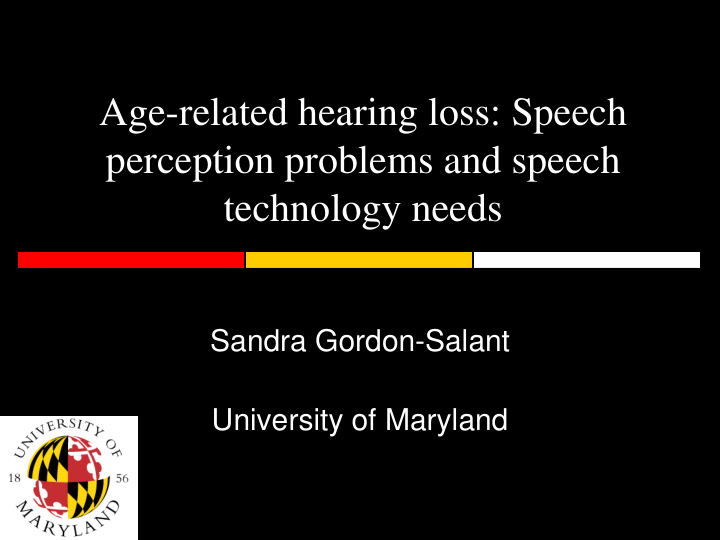



Age-related hearing loss: Speech perception problems and speech technology needs Sandra Gordon-Salant University of Maryland
Hearing Research Lab at UMD General focus of lab Currently funded research projects: Auditory temporal processes, speech perception, and aging (NIA, NIH; co-investigators are P. Fitzgibbons and G. Yeni-Komshian) Functional hearing evaluation for military occupational specialties (collaboration with D. Brungart at Walter Reed; funded by Creare, Inc.) Multi-site study of the efficacy of speech perception training in hearing aid users (NIDCD, subcontract with Communication Disorders Technology – C. Watson, J. Miller, J. Dubno, M. Leek) Speech processing algorithms for older listeners with hearing loss (collaboration with C. Espy-Wilson; funded by ADVANCE grant via NSF)
Senescent changes in auditory system and cognition Decline in peripheral auditory Source: U.S. Census Bureau, 2012 nervous system reduced ability to detect high frequency information Reduced ability to code rapid signal onsets Decline in central auditory nervous system Reduced neural synchrony leading to distorted perception Slowed neural processing Prevalence of age-related Reduced inhibitory mechanisms hearing loss: approx. 50%; Decline in cognitive function Number affected: 24 million working memory capacity people > 65 yrs with hearing selective attention loss today speed of information processing
Impact on speech understanding: noise and rapid speech Difficulty recognizing speech in noise Difficulty understanding rapid speech Mostly predicted by AI theory (fixed SNR, Time compression steady-state noise, single target talker) Naturally fast speech In adaptive conditions with MT babble, older people have more difficulty in noise than younger people Partly associated with ↓ in cognitive ability Low probability sentences Yng Norm 100 Older Norm NU6 Words Yng HI 4 Percent Correct Recognition Older HI Younger Older Younger Older Signal-to-Noise Ratio (dB) 80 n = 15/grp 3 2 60 1 0 40 -1 -2 20 n = 13/group -3 High Low High Low 0 Working Memory Groups 30% 40% 50% 60% Time Compression Ratio (%) Cole & Gordon-Salant, 2014 Gordon-Salant & Fitzgibbons, 1993
Impact on speech understanding: accented English Difficulty understanding accented speech Difficulty using cues for speech in quiet segregation in noise, with accented talkers Unaccented Talker Sentences Signal-to-Noise Ratio (dB) 15 Yng Norm Older Norm Older Hrg Imp 10 n = 15/grp 100 Yng Norm NF = native Percent Correct Recognition Yng NM female 5 Older Norm 90 Older HI 0 NM = native n = 15/group male 80 -5 NFM = native -10 female + male 70 NF NM NFM NNM N+NNM SMN Background Noise Condition NNM = non- 60 Moderately Accented Talker native male Signal-to-Noise Ratio (in dB) 15 50 N+NNM = native none mild moderate + non-native 10 male Accent Condition 5 SMN = speech- Significant main effects: accent (p<.01) and group (p<.01) modulated noise 0 Yng Norm -5 Older Norm Older Hrg Imp -10 NF NM NFM NNM N+NNM SMN Background Noise Condition Gordon-Salant, et al., 2010 Gordon-Salant et al., 2013
Current speech technology: Implications Challenges Hearing aid use : ≈ 25% among older Lack of data on speech HI people understanding performance among older adults: Hearing aids don’t alter the signal in the time domain; continuing difficulty While using the telephone & tv in noisy environments While using assistive hearing Cochlear implants: used by technology (including CI’s) increasing proportion of older people Who are native speakers of languages other than English High rates of electrode stimulation – probably not beneficial as people Low use of technology by older age people (Pew Research Center, 2012) Telephone communications: GI All adults Generation (age 18+) Difficulty on telephone – listening to (age 76+) fast speech, accented speech, % of adults who own this device computer-generated speech Cell phone 56% 88% Television viewing: Desktop 31% 58% Laptop 20% 61% Older people with hearing loss E-reader 5% 18% understand 40% of the spoken message (in quiet, even with hearing aids) Tablet 3% 18%
Targeted areas of research for funding Development of technology to slow down speech in a wearable device and in telephones that preserves intelligibility and accommodates talker variability; Conversion of accented English to more native-like English, in a wearable device or speech-to-text; Modifications in cochlear implant technology and hearing aids to accommodate slowed processing and difficulty in noise, and that actually show benefit by older people; Efficacious training strategies to facilitate learning/plasticity in older people for adapting to new technologies; Acceptability of new devices (including hearing aids and telephone technology) for older people; Does advanced speech technology improve quality of life?
Thank you!
Recommend
More recommend